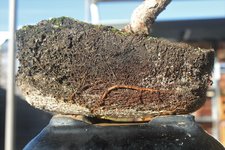My JBP tend to drop older needles earlier, through summer.
Trying to count sections of growth to work out age of needles is more difficult when trees have been pruned but I'd be pretty confident that most of those brown needles are only 2 years and should not be dropping until next summer.
I would be looking at stress as a factor. The trouble with pines is they do not show stress until many weeks after the event by which time we have usually forgotten that we missed a couple of days watering. With the wet summer we have had it was easy to let them get a bit dry on the occasional weeks it did not rain. It could also be unseen root stress related to soil staying too wet, especially given we have had such a wet season down here.
Definitely check for pests and disease.
Also consider nutrient stress though my experience there is usually yellow needles rather than brown and drying.
Thank you for your reply neil,i always appreciate your advice.
One thing i havnt checked for ages is the root system. The tree is quite pot bound and last time i looked,the roots were coiling at the bottom of the pot without any soil around them. They were still very healthy and plump but that was probably at the start of the growing season just gone.
Im not 100% sure how to water the JRP correctly, ive been soaking until water comes out of the drainage hole (making sure the soil is saturated) and then letting it dry again before rewatering.
Im watering the tree every day in the warm sunny weather we're getting at the moment, it dries out daily.
Otherwise,i only water the tree when dry.
I'll have a good look over the tree for any pest or disease and get on to that instantly if i spot something.
Im not sure how old the inner needles are but they were the oldest growth on the tree when i cut the branching back...i cut back into those particular needles to stimulate the new growth and try and get some back budding happening.
It budded up quite well and the new needles were half the size (still need to be smaller but a good reduction in one season).
There wasnt a lot of actual back budding,nothing really on the bare wood...all the new growth was produced from the older needles i cut back into, alot of it accumulating around the areas where i had back to.
The tree's feeding regime' has been a bit all over the place this growing season. I think at one stage i may have put some pellet feed on the tree that was high in Nitrogen...like 14%.
I just had a bad feeling and removed a lot of it...probably 2 days after application.
Thats about all i can think of at the moment...sorry for the wall of words neil and again,thank you.










